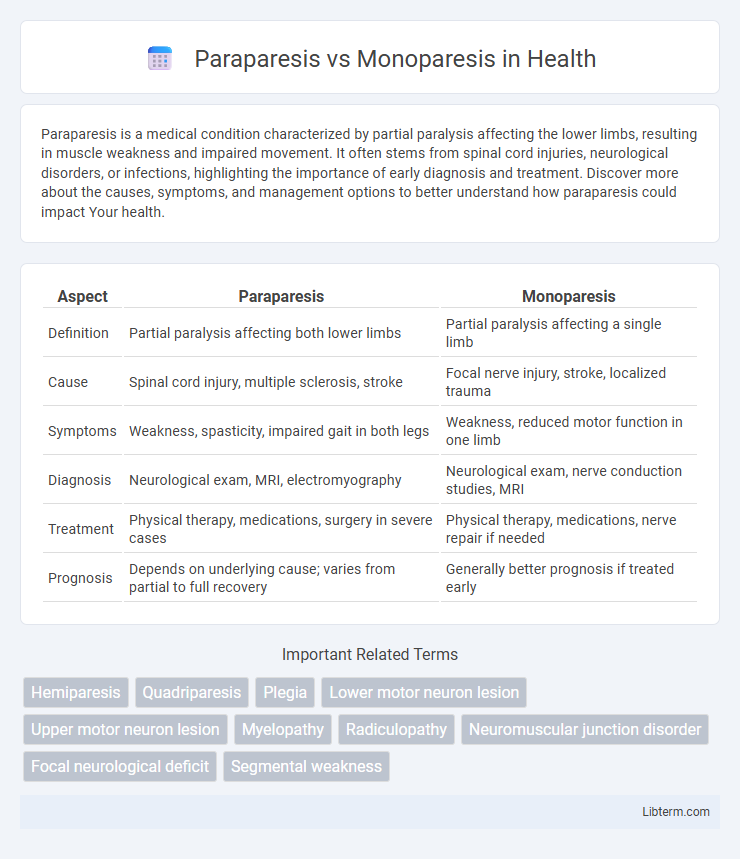Paraparesis is a medical condition characterized by partial paralysis affecting the lower limbs, resulting in muscle weakness and impaired movement. It often stems from spinal cord injuries, neurological disorders, or infections, highlighting the importance of early diagnosis and treatment. Discover more about the causes, symptoms, and management options to better understand how paraparesis could impact Your health.
Table of Comparison
| Aspect | Paraparesis | Monoparesis |
|---|---|---|
| Definition | Partial paralysis affecting both lower limbs | Partial paralysis affecting a single limb |
| Cause | Spinal cord injury, multiple sclerosis, stroke | Focal nerve injury, stroke, localized trauma |
| Symptoms | Weakness, spasticity, impaired gait in both legs | Weakness, reduced motor function in one limb |
| Diagnosis | Neurological exam, MRI, electromyography | Neurological exam, nerve conduction studies, MRI |
| Treatment | Physical therapy, medications, surgery in severe cases | Physical therapy, medications, nerve repair if needed |
| Prognosis | Depends on underlying cause; varies from partial to full recovery | Generally better prognosis if treated early |
Understanding Paraparesis and Monoparesis
Paraparesis refers to partial paralysis affecting both legs, commonly caused by spinal cord injuries, multiple sclerosis, or infections, leading to weakness and impaired motor function. Monoparesis involves weakness or partial paralysis confined to a single limb, often resulting from localized nerve damage, stroke, or traumatic injury. Understanding the distinct neurological pathways and affected regions helps differentiate paraparesis, which impacts bilateral lower limbs, from monoparesis, confined to unilateral motor deficit, guiding appropriate diagnostic and therapeutic strategies.
Key Differences Between Paraparesis and Monoparesis
Paraparesis involves partial paralysis or weakness affecting both legs, often caused by spinal cord injuries, multiple sclerosis, or hereditary spastic paraplegia, whereas monoparesis refers to weakness localized in a single limb due to peripheral nerve injury or stroke. The extent of motor impairment in paraparesis is bilateral and symmetrical, while monoparesis presents as unilateral and isolated weakness. Diagnostic evaluation centers on neurological examination and imaging studies to identify the precise lesion location responsible for these differing patterns of motor dysfunction.
Common Causes of Paraparesis
Paraparesis refers to partial paralysis or weakness of both legs, commonly caused by spinal cord injuries, multiple sclerosis, and hereditary spastic paraplegia, whereas monoparesis involves weakness in a single limb, often resulting from localized nerve damage or stroke. The most frequent causes of paraparesis include spinal cord compression due to trauma or tumors, inflammatory diseases such as transverse myelitis, and neurodegenerative disorders affecting the corticospinal tracts. Understanding these distinctions aids in targeted diagnosis and treatment planning for patients presenting with limb weakness.
Typical Causes of Monoparesis
Monoparesis refers to weakness affecting a single limb or muscle group, commonly caused by localized nerve injury, peripheral neuropathy, or focal brain lesions such as stroke or multiple sclerosis plaques. In contrast, paraparesis involves weakness in both lower limbs, often resulting from spinal cord compression, hereditary spastic paraplegia, or transverse myelitis. Understanding these distinct etiologies helps guide diagnostic evaluation and targeted treatment strategies in neurology.
Clinical Symptoms: Paraparesis vs Monoparesis
Paraparesis presents with symmetrical weakness affecting both lower limbs, often accompanied by spasticity, increased deep tendon reflexes, and gait disturbances. Monoparesis involves weakness localized to a single limb, typically with reduced muscle strength and possible sensory deficits, without generalized spasticity. Both conditions require thorough neurological examination to differentiate underlying causes based on the pattern and distribution of motor impairment.
Diagnostic Approaches for Both Conditions
Paraparesis and monoparesis require distinct diagnostic approaches focused on neurological examination and imaging studies to identify the extent and location of motor weakness. Magnetic resonance imaging (MRI) is essential for visualizing spinal cord or brain lesions in paraparesis, while electromyography (EMG) and nerve conduction studies often aid in diagnosing peripheral nerve involvement in monoparesis. Laboratory tests, including blood panels and cerebrospinal fluid analysis, support differential diagnosis by ruling out inflammatory, infectious, or metabolic causes in both conditions.
Treatment Strategies for Paraparesis
Treatment strategies for paraparesis primarily involve physical therapy to improve muscle strength and coordination, along with pharmacological interventions such as corticosteroids or antispasticity agents like baclofen to reduce inflammation and muscle stiffness. In cases caused by underlying neurological disorders, addressing the primary condition through surgery or disease-specific treatments is crucial for optimal recovery. Rehabilitation programs integrating occupational therapy and assistive devices enhance mobility and daily functioning for paraparesis patients.
Management Options for Monoparesis
Monoparesis management focuses on targeted physical therapy to improve strength and motor function in the affected limb, often accompanied by orthotic devices to support mobility and prevent contractures. Pharmacological treatments may include muscle relaxants or pain relievers when spasticity or neuropathic pain is present. In some cases, surgical interventions, such as nerve decompression or tendon transfer, are considered to restore function depending on the underlying cause of the monoparesis.
Prognosis and Outcomes: Paraparesis vs Monoparesis
Paraparesis typically results from spinal cord injuries or neurological disorders affecting both lower limbs, often leading to more extensive motor impairment and slower recovery rates compared to monoparesis. Monoparesis, characterized by weakness in a single limb, usually presents a better prognosis with higher chances of functional recovery due to localized nerve involvement. Early intervention and targeted rehabilitation significantly impact outcomes in both conditions, but patients with paraparesis generally face longer rehabilitation periods and increased risk of chronic disability.
Preventive Measures and Rehabilitation
Paraparesis prevention focuses on managing underlying neurological conditions such as multiple sclerosis or spinal cord injuries through early diagnosis, appropriate medication, and lifestyle adjustments like regular physical activity and avoiding trauma. Rehabilitation for paraparesis emphasizes intensive physical therapy, mobility training, and assistive devices to enhance lower limb strength and functional independence. Monoparesis prevention involves controlling risk factors like diabetes, nerve compression, or vascular issues to avoid localized nerve damage, while rehabilitation targets specific muscle groups with tailored exercises and occupational therapy to restore targeted limb function.
Paraparesis Infographic

 libterm.com
libterm.com